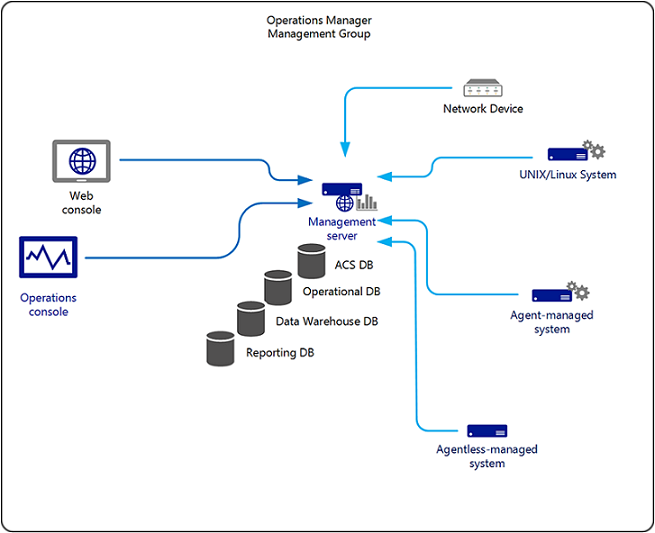Single-server deployment of Operations Manager
The single-server management group scenario combines all the management group roles that can coexist onto a single server running as a member server in an Active Directory domain. This instance can be on dedicated hardware or on a virtual computer. You can deploy the Operations console to computers other than the single server, and access the web console with a browser.
You deploy Operations Manager in a single-server management group when you want to use it for evaluation, testing, and management pack development, usually in a lab, development, or non-production environment.

Operations Manager services
The single-server management group configuration supports the following services:
Monitoring and alerting
Reporting (available in the Operations console but not in the web console)
Audit collection
Agent-less exception management
Data (accessed by using the web console and the Operations console)
Operations Manager features
The single-server management group configuration combines these features:
Audit Collection Services (ACS) collector
ACS database
ACS forwarder
Operational database
Operations console
Reporting data warehouse database
Reporting database
Reporting server
Web console server
Command Shell
Restrictions
The single-server management group configuration is the easiest to deploy, but there are limitations to its capabilities and therefore limitations to what it's commonly used for.
Gateway server
This configuration doesn't include the gateway server role. Because of this, all monitored devices must be in the same Active Directory forest as the management server or you must use certificates on both the managed computer and the management server to provide for mutual authentication.
High availability and redundancy
The single server, single management group resides on a single set of hardware or virtual machine. This configuration supports only one instance of each server role and therefore doesn't support agent failover between management servers.
Common uses
This configuration is most commonly used for evaluation, testing, and management pack development purposes, usually in non-production or pre-production environments. Single-server management group configurations generally lack the robustness and performance to support anything but the smallest production loads.
Ports used
In this configuration, you need to ensure that network ports are opened for communication between the agents and the management server, between the Operations console and the management server, and between the Web console and the management server. All other inter-service communication occurs on the management server itself. The ports are as follows:
Operations console to management server: TCP 5724
Operations console to Reporting server: TCP 80
Web console to Web console server: TCP 51908 is the default port when you select Windows Authentication. If you chose Forms Authentication, the port will be user-defined.
Agent to management server: TCP 5723
ACS forwarder to ACS collector: TCP 51909
Agentless management: occurs over remote procedure call (RPC) dynamic port
Management server to UNIX\Linux computer: TCP 1270
Management server to UNIX\Linux computer for special discovery and troubleshooting: TCP 22
For a complete listing of ports used, the direction of the communication, and if the ports can be configured, see Configuring a Firewall for Operations Manager.
Next steps
- To deploy Operations Manager in a single server management group, see Walkthrough: Installing Operations Manager on a Single Server.